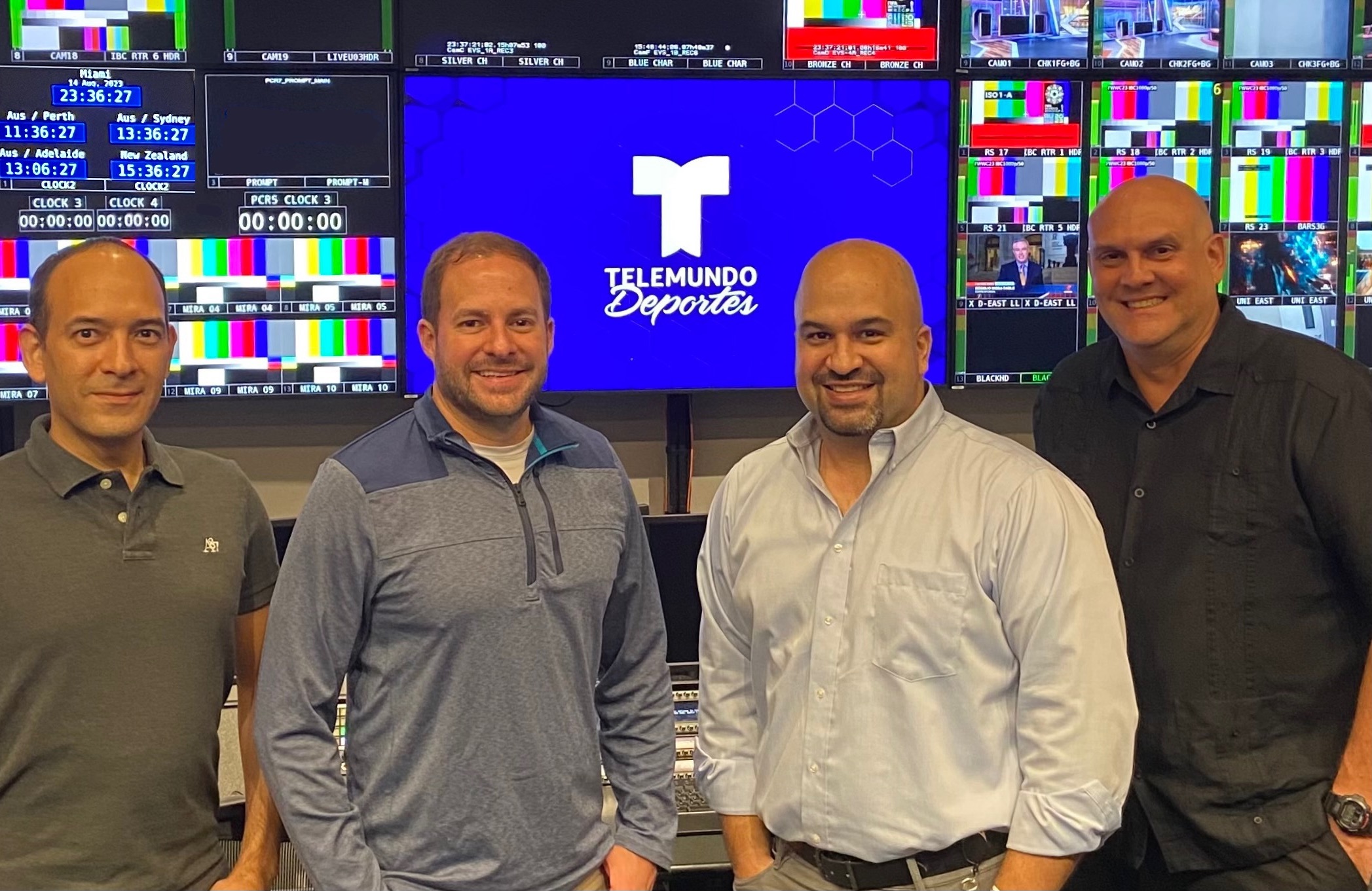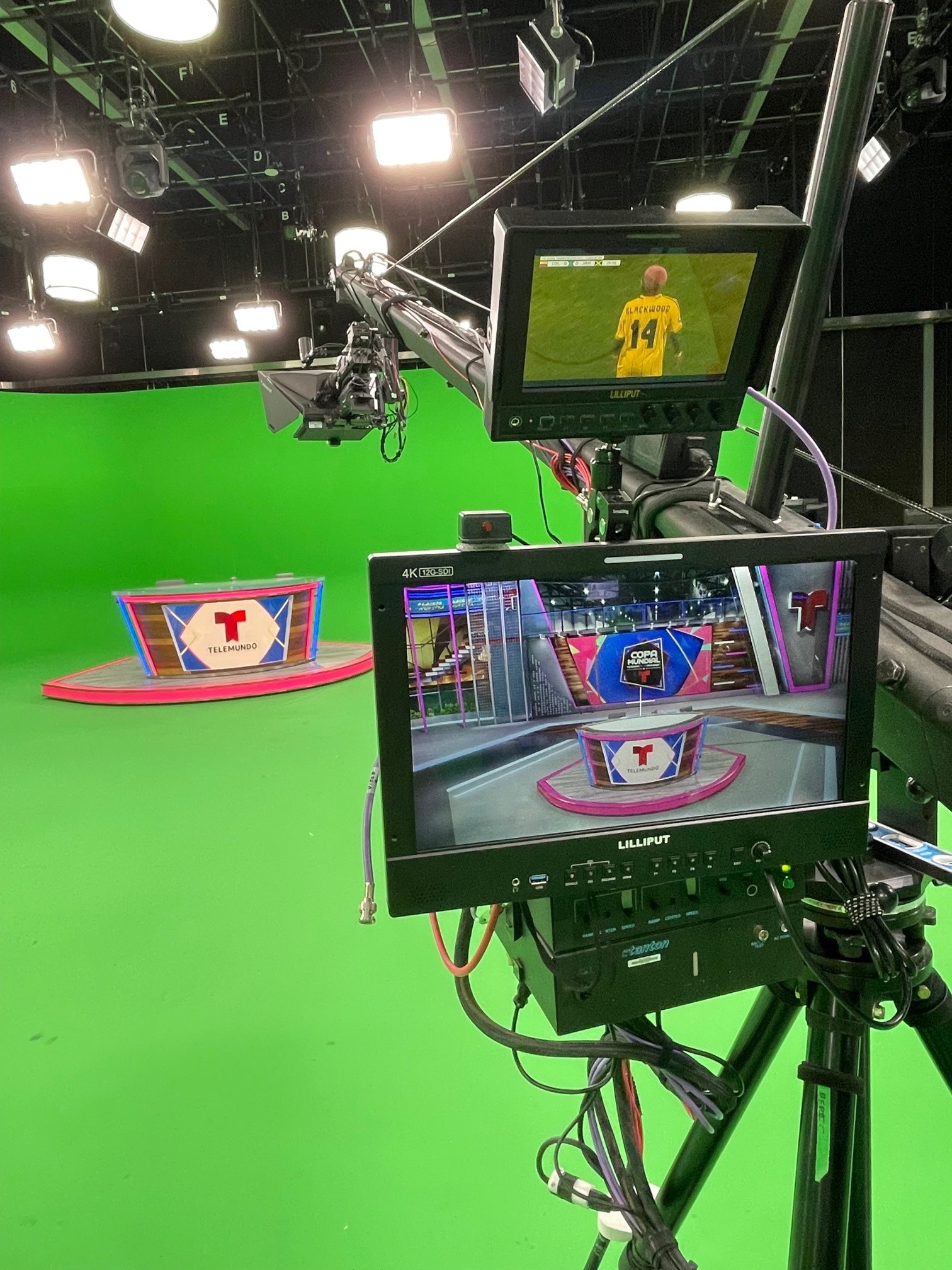FIFA Women’s World Cup: Telemundo Deportes Enhances 4K HDR Coverage With 5.1 Audio, Virtual Studio
Operation relies on improved connection between facility in Miami and the IBC in Sydney
Story Highlights
Heading into a tantalizing 2023 FIFA Women’s World Cup Final between Spain and England, Telemundo Deportes is nearing the conclusion of a month-long stretch of native-HDR productions from its base in Telemundo Center. Besides deploying 5.1 audio as well as programming with an updated virtual studio, the broadcaster’s engineering team has done an impressive job seamlessly connecting their Miami-based facility and their setup in the IBC in Australia.
“Our biggest driver was to treat the IBC as an extension of Miami,” says Jorge Duarte, senior director, production engineering, Telemundo Deportes. “It’s a small yet efficient footprint, so we’ve kept the workflows as straightforward as possible since a 14-hour time difference and being halfway around the world has its own challenges that we’ve had to overcome.”
Football in HDR: Telemundo’s First Women’s World Cup in Native High Dynamic Range
After debuting HDR productions for two opening matches — New Zealand vs. Norway and Australia vs. Ireland — on July 20, Telemundo Deportes has refined its new technological workflow. Prior to the start of the tournament, Duarte and his crew — Senior Engineer, Production Engineering, Rene Rattia; Manager, Production Engineering, Luis Schneider; Architect, Production Engineering, Ricardo Novas; Director, Post-Production Engineering, Joel Rulan; and Senior Network Architect Ramon Munoz — used other international and large-scale competitions to test out this production wrinkle, including the 2021 Tokyo Summer Olympics and the 2022 FIFA Men’s World Cup in Qatar. The team was supported by Director, Control Room Operations, Rey Carrasquillo; Manager, Control Room Operations, George Rodriguez; and Technical Project Manager Odair Auger.

From left: Telemundo Deportes’ Rene Rattia, Luis Schneider, Jorge Duarte, and Ricardo Novas produce the FIFA Women’s World Cup from Telemundo Center in Miami.
Over the past month, Duarte’s staff working in Miami has teamed with SVP, Content Operations, Chris Suarez-Meyers and the crew at the IBC to receive the necessary video feeds from HBS and send out the finished product. This comprises nearly 30 live game feeds as well as various signals captured around the two host nations via LiveU and sent directly to Miami. The game feeds are natively produced in the HLG HDR format and distributed as 4K PQ/HDR. In the control room, the feeds are managed by Technical Directors Red Osejo and Adrian Izquierdo, with the assistance of Manager, Technical Operations, John Moneyhun and Senior Network Operations Coordinator Yerica Areas in the Telemundo Technical Operations Center coordinating all feeds originating in Australia and New Zealand.
Although the Women’s World Cup is one of the main priorities, Telemundo Center is always producing other news, sports, and entertainment. Since all other Telemundo programming is sent out in standard 1080i SDR format, one of the biggest challenges has been to retrofit the live-production infrastructure to seamlessly support the two production formats on demand.
“Being able to keep our standard 1080i SDR workflows in place when we’re not doing Women’s World Cup was very important,” says Duarte. “After working overnight for eight to 10 hours and two games, we needed a reliable method of switching between HDR and SDR productions easily. That meant having the production team do it themselves in 15 minutes rather than four hours.”
This 4K HDR operation is raising the visual quality of Telemundo Deportes’ World Cup coverage overall.
“We’ve taken notice that our downconverted 1080i SDR has also looked much better,” says Duarte. He credits NBCU Operations and Technology Director, Advanced Content Production, Chris Seeger: “We’ve relied on Chris’s expertise in live HDR production workflows to optimize our HDR and SDR production paths and conversions between those formats.”
Immersive Audio: 5.1 Brings Sounds of the Game Closer to Viewers
It’s a treat for supporters at each venue to hear the chants, the sound of the ball being kicked, the roar when a country scores. For fans watching from home, Telemundo Deportes is capturing and reproducing that live in-venue experience with 5.1 immersive sound. This aspect of the production is led by Manager, Audio Operations, Pedro Hernandez and Audio Specialists Manuel Funcia and Luis Diaz. The 5.1 surround sound is mixed at Telemundo Center and sent to all local networks and to Peacock, which is setting daily streaming records with the Women’s World Cup.
Telemundo Deportes sibling NBC Sports has supplied 5.1 sound and Dolby Atmos audio to viewers for multiple events. One of the most recent global events under the NBC Sports umbrella, the 2022 Beijing Winter Games, was a master class in audio production. It was so well-received and applauded by the sports-broadcasting industry that the broadcaster brought home the 2023 Sports Emmy for Outstanding Audio/Sound – Live Event. Coming off this win and another successful execution of this strategy, Telemundo Deportes tapped the expertise of NBC Sports Senior Director, Audio Engineering, Karl Malone.
“We kicked [this idea] off internally,” says Duarte, “but, since we’re a big company, we try to leverage each other. We leaned on Karl quite a bit. He came down in February (with NBC Sports A1s Mike DiCrescenzo and Rick Bernier) to meet with our audio team.”
Most of the games produced by Telemundo Deportes rely on offsite commentary by announce teams in Miami. It’s one of the biggest changes from the 2022 FIFA Men’s World Cup, which was concentrated in the Qatari capital of Doha, allowing the broadcaster to rotate multiple announce teams to all eight participating stadiums. With this Women’s World Cup spanning two countries, the team adapted by adding commentary to inbound video feeds.
“[In Qatar,] all audio was already mapped with game commentary,” Duarte explains. “Now it’s going in between Miami and Australia or New Zealand, so we had to make sure that our workflow accounted for that. In addition, our control rooms are having to handle the recording and archiving of this feed as well.”
Upping Virtual Tech: AR Studio Creates New Home for Programming
To extend the footprint of the studio set at Telemundo Center, the bulk of the on-air programming before and after the match and at halftime leverages augmented reality in virtual Studio L. Beginning with the Tokyo Olympics, the broadcaster’s first large-scale virtual production, Director, Realtime Graphics, Fabian Albarracin; Real-Time Graphics Specialist Diego Soto; and Technical Artist Osmany Gomez upgraded the set with Chyron’s PRIME VSAR platform and Unreal Engine as well as a four-camera setup. The result is dazzling, but the cost-effectiveness of the decision has enhanced productions of a wide variety of productions.
“Since it’s one set of hardware and one system,” Duarte notes, “we could use it for anything from news in the afternoon to other sports throughout the day. The biggest benefit is being able to go back and forth without having to switch the physical set three or four times a day.”
From a creative standpoint, Albarracin and his staff constantly adjust to the changes in the tournament. Getting the virtual studio ready requires that they put the high-quality graphics together quickly.
“They’re tasked with making sure that the graphics are performing to what is expected,” adds Duarte. “You can sometimes overdo a virtual set, where the rendering doesn’t look as good. So they put a lot of work into tweaking the sets.”
Improved Workflows: Telemundo Deportes Looks Forward to ’26 World Cup at Home
With each subsequent FIFA World Cup, Telemundo Deportes not only gains increased viewership but also improve its production and operations. Whether the pandemic-inspired reliance on remote and cloud-based workflows or the improved communication between stateside crew and onsite staffers, broadcasts of the 2023 FIFA Women’s World Cup have been the culmination of hard work and dedication.
“We learn a tremendous amount from every event as well as understand how to make our shows even better for the next one,” says Duarte. “We’re looking forward to 2026, where we can take our work being done now and grow it exponentially.”
Telemundo Deportes will produce coverage for two more matches: the third-place match between Sweden and Australia on Saturday, Aug. 19 at 4 a.m. ET and the Final between Spain and England on Sunday, Aug. 20 at 6 a.m.


